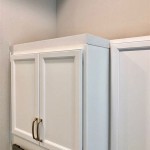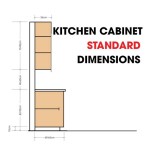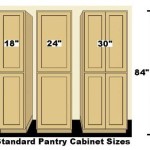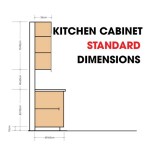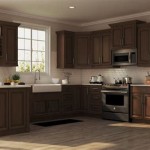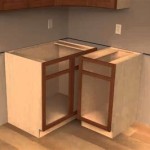```html
Powder Coated Kitchen Cabinet Doors: A Comprehensive Overview
Powder coating has emerged as a prominent finishing technique for kitchen cabinet doors, offering a durable and aesthetically pleasing alternative to traditional painting methods. This article provides a detailed examination of powder coated kitchen cabinet doors, encompassing their advantages, disadvantages, application process, available options, cost considerations, and maintenance requirements.
Durability and Resistance
One of the primary benefits of powder coating kitchen cabinet doors is their exceptional durability. The powder coating process involves applying a dry, free-flowing thermoplastic or thermoset powder electrostatically to a surface. The coated item is then cured under heat, allowing the powder to melt and form a uniform, hard, and resilient finish. This results in a surface that is significantly more resistant to chipping, scratching, fading, and corrosion compared to conventional liquid paints.
The robust nature of powder coating makes it ideally suited for the demands of a kitchen environment. Kitchen cabinets are frequently exposed to moisture, grease, and cleaning agents, all of which can degrade traditional paint finishes over time. Powder coating provides a protective barrier against these elements, extending the lifespan of the cabinet doors and reducing the need for frequent repainting or replacement.
The resistance to chipping and scratching is particularly advantageous in households with children or pets, where accidental impacts are more likely. Powder coated surfaces can withstand the daily wear and tear of a busy kitchen, maintaining their appearance for years to come.
Furthermore, powder coating offers superior corrosion resistance compared to many other finishing methods. This is particularly important in areas with high humidity or where cabinets are exposed to water splashes. The dense, non-porous nature of the powder coating film prevents moisture from penetrating the underlying substrate, thereby inhibiting rust and corrosion.
Aesthetic Versatility and Design Options
Beyond its durability, powder coating offers a wide range of aesthetic possibilities for kitchen cabinet doors. The process allows for a virtually unlimited selection of colors, finishes, and textures, providing designers and homeowners with ample creative freedom.
Colors can be matched to virtually any existing décor or desired aesthetic. Custom color matching services are readily available, ensuring that the powder coated cabinet doors seamlessly integrate into the overall kitchen design. The color consistency achieved through powder coating is also superior to that of liquid paints, resulting in a uniform and visually appealing finish across all cabinet doors.
In addition to a wide spectrum of colors, powder coating can be applied to create a variety of finishes, including glossy, matte, satin, and textured surfaces. Glossy finishes provide a sleek and modern look, while matte finishes offer a more subtle and understated appearance. Satin finishes strike a balance between the two, providing a slight sheen without being overly reflective. Textured finishes can add depth and visual interest to the cabinet doors, mimicking the look and feel of materials such as wood or metal.
The ability to create textured finishes is a significant advantage of powder coating. It allows for the incorporation of tactile elements into the kitchen design, adding a unique dimension to the cabinet doors. These textured finishes can also help to conceal minor imperfections in the underlying substrate.
Furthermore, powder coating can be applied to a variety of materials, including metal, wood, and MDF (Medium-Density Fiberboard). This versatility allows for the creation of diverse design styles, from contemporary metal cabinets to traditional wood cabinets with a durable finish.
Application Process and Environmental Considerations
The powder coating process involves several key steps, each of which contributes to the final quality and durability of the finish. Understanding these steps is crucial for appreciating the benefits of powder coated kitchen cabinet doors.
The first step is surface preparation. The cabinet doors must be thoroughly cleaned and degreased to remove any contaminants that could interfere with the adhesion of the powder coating. This may involve sandblasting, chemical etching, or other surface treatment methods.
Next, the powder coating is applied. This is typically done using an electrostatic spray gun, which charges the powder particles and directs them towards the grounded cabinet door. The electrostatic charge causes the powder to adhere to the surface, creating a uniform coating.
Once the powder coating has been applied, the cabinet doors are placed in a curing oven. The oven is heated to a specific temperature, which causes the powder to melt and flow together, forming a smooth, continuous film. The curing process also cross-links the powder coating polymers, creating a durable and chemically resistant finish.
The environmental benefits of powder coating are also noteworthy. Unlike liquid paints, powder coatings do not contain volatile organic compounds (VOCs), which are harmful to human health and the environment. This makes powder coating a more eco-friendly finishing option.
The absence of VOCs also eliminates the need for solvent-based cleaning agents, further reducing the environmental impact of the process. In addition, any overspray of powder coating can be collected and reused, minimizing waste.
Cost Analysis and Long-Term Value
The initial cost of powder coated kitchen cabinet doors may be slightly higher than that of traditional painted doors. However, the superior durability and longevity of powder coating often result in a lower total cost of ownership over the lifespan of the cabinets.
The reduced need for repainting or replacement is a significant factor in the long-term cost savings. Powder coated cabinets can withstand years of use without showing signs of wear and tear, whereas painted cabinets may require frequent touch-ups or complete refinishing.
Furthermore, the resistance to chipping, scratching, and corrosion helps to maintain the value of the cabinets over time. This is particularly important for homeowners who may eventually sell their property. Kitchen renovations are a common way to increase home value, and durable, aesthetically pleasing cabinet doors can be a significant selling point.
When comparing the costs of powder coating to other finishing methods, it is important to consider the long-term benefits and potential cost savings. While the initial investment may be higher, the extended lifespan and reduced maintenance requirements can make powder coating a more cost-effective option in the long run.
Maintenance and Cleaning
Maintaining powder coated kitchen cabinet doors is relatively simple and straightforward. The smooth, non-porous surface is easy to clean with a soft cloth and mild detergent. Avoid using abrasive cleaners or scouring pads, as these can damage the finish.
For stubborn stains or grease buildup, a solution of warm water and a small amount of dish soap can be used. Rinse the surface thoroughly with clean water and dry it with a soft cloth.
Regular cleaning will help to maintain the appearance of the powder coated cabinet doors and prevent the buildup of dirt and grime. This will also help to extend the lifespan of the finish.
In cases where minor scratches or chips occur, touch-up paint can be used to repair the damage. Consult with the powder coating manufacturer or supplier to obtain the appropriate touch-up paint for your specific finish.
By following these simple maintenance guidelines, homeowners can ensure that their powder coated kitchen cabinet doors remain in excellent condition for many years to come.
```
Factory Moisture Proof Metal Frame Cabinets Modern Black Waterproof Aluminum Profiles Kitchen Cabinet Designs China Design Made In Com

Powder Coated White Aluminium Kitchen Cabinet Door Thickness 4 Mm

Hinged Door Powder Coated Aluminium Kitchen Cabinet

Aluminium Carcass Series Alloy Kitchen

Hinged Door Powder Coated Aluminium Kitchen Cabinet

How To Choose Aluminium Kitchen Cabinet Door 3g 4g Or Wood Grain

Modern Powder Coated Aluminium Modular Kitchen Cabinet

Outdoor Kitchen Cabinet Materials The 5 Most Popular Types Outeriors

Aluminium Carcass Series Alloy Kitchen

Hinged Door Powder Coated Black Aluminum Kitchen Cabinet For Home
Related Posts

